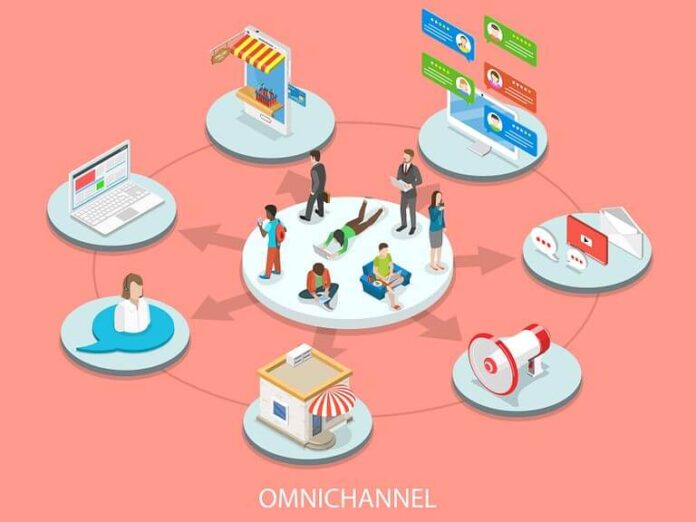The Omnichannel strategy is based on the simultaneous and interconnected use of different communication channels, with the aim of strengthening the relationship between online and offline. In this way, the customer experience is perfected
The modality, known as Omnichannel in English, allows the user to use an application to find a shoe, try it on at the store and receive it at home.
In this post you will learn the concept of omnichannel and understand the reasons that led to this term becoming so well known and used today.
I anticipate that the omnichannel strategy is, at the same time, an innovation and a response to customer demand for a better shopping experience, more complete and with fewer barriers between online and offline media.
And to begin to understand this term, let’s first look at its meaning. Let’s go!
What is omnichannel?
If we break down the omnichannel term we have on the one hand the prefix “omni”, which in Latin conveys the meaning of everything and whole and on the other hand we have “channel” which is a Spanish word used to replace the original term in English, “ channel ”
That is, the closest meaning would be something in the sense of all channels .
However, that is not enough to understand about the power and scope of this term.
When we limit ourselves only to the semantics of the word, we can confuse omnichannel with multichannel and / or crosschannel – other terms also widely used.
All of them refer to the user experience with the channels offered by the brands, for this reason they can convey the false feeling of having the same meaning.
So that this does not happen, we separate each of the terms with their respective definitions and examples below:
Multichannel
When we speak in multichannel we have the prefix “multi” that refers to many.
An example of a multi-channel strategy is when a company offers multiple purchasing channels, such as the site, the application, and the physical stores.
However, they are not connected. Sellers working in the physical store do not know about the purchases that were made by the application and / or the site and vice versa.
There is competition between purchasing channels and there is no exchange of information between them.
Crosschannel
The prefix “cross” in Spanish means to cross.
In a crosschannel strategy, the channels of a brand can be crossed in the following way: the purchase can be made online on the company’s website and the withdrawal of the purchased product can be done in the physical store.
In this way, there is no competition between the channels, once they complement each other.
Omnichannel
As we said at the beginning of the post, the prefix “omni” refers to all. In this case, all the channels of a company are connected.
You can, even being inside the physical store, use the brand’s application to verify if the specific product you want exists.
If you find it through the application, you can make the order with one of the vendors of the physical store and choose to receive the delivery at your home.
Have you noticed that all the purchase options are interconnected simultaneously?
In this way, one channel helps the other to offer an increasingly better shopping experience and to further strengthen online and offline relationships.
In addition, the information collected on the movements of consumers by all channels favors that your sales funnel is more increased and, therefore, efficient.
Why is there so much talk about omnichannel?
The strategy of transforming consumption into a unique and increasingly practical experience is a challenge that several companies are trying to meet. This is because consumers are becoming more demanding and want more comfort.
Offering online channels for shopping and customer service is no longer a novelty, but a requirement for brands that want to survive in such a competitive market.
As we have seen, the omnichannel offers a new and more complete shopping experience for the user and that is why this term has been used so much lately.
Despite being practiced by some brands, this strategy is still relatively recent and may be the differential that your business needs to stand out from the competition.
Benefits of an omnichannel strategy
Investing in a better experience for your clients will give you several benefits, in the end all this work aims to make them more satisfied .
By leaving them happy, your business has more possibilities to improve:
-
- the services offered;
-
- the sales ;
-
- the loyalty process ;
- and the image of your brand .
With this strategy, all the points of contact with your clients will be developed to optimize these processes. And that will represent a valuable profit for your company that can grow from the analysis of the corresponding metrics.
How to transform your business into an omnichannel?
Now that you know more about the omnichannel strategy and its advantages, we are going to learn how to apply it in your business.
As we have already said in this post, the objective is to improve customer satisfaction. And to conquer that challenge, the first step is to get to know the Buyer Persona of your business.
Once created, it will be possible to know innumerable information, including your purchasing habits. This knowledge will allow your company to better understand the demands of these customers and offer something truly valuable and appropriate.
After you created your person, you can go to the next step: integrate your company’s channels. Once the channels are defined, it will be necessary to personalize them according to the information obtained in the construction of the Buyer Persona.
This integration means aligning online media with offline media so that there are no gaps for the user and, of course, also aligning the areas of your company (sales, marketing, support, etc.).
After that, it is time to try everything that has already been done. In addition to verifying the operation, it will also be necessary to evaluate the quality of the integration and the channels.
For this, ask the people who present a profile similar to that of your Buyer Persona – after all, all the actions were focused on it – to test the implementations.
Following these steps will reduce the risks and possible failures of your omnichannel strategy and, in addition, you will know if any type of change or adjustment is necessary before launching it on the market.
What are the main challenges of the omnichannel?
In the previous topic, we discussed how to implement the omnichannel strategy in your business and now we want to make it clear that it is not so easy. Integrating channels and delivering a great customer experience is a big challenge .
In addition to relying on technology for this integration, you also need a deep understanding of the business and careful monitoring of all sectors.
Added to this challenge is customer satisfaction, something delicate and involving the expectation and opinion that they have of your company.
To give you an idea of how difficult it is, the Omnichannel Customer Service Gapda Zendesk survey noted that 87% of respondents believe that brands need to work harder to create a seamless experience for their consumers.
conclusion
We reached the end of the post and we hope you have learned enough about the omnichannel strategy to apply it in your business. In the event that you have any questions, tell us in the comments.
Among the discoveries, we have seen that the omnichannel is a challenge, but that if it is well prepared it can provide incredible results for your business and the long-awaited differential in the market.
And to help you get started on this strategy, take a look at the Vendarketing ebook and learn how to align Marketing and Sales teams to increase your business performance!













